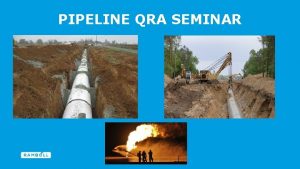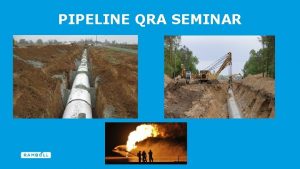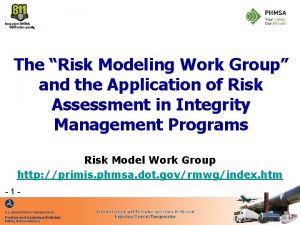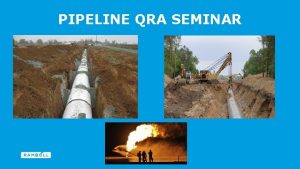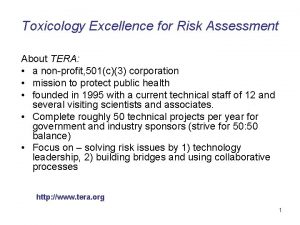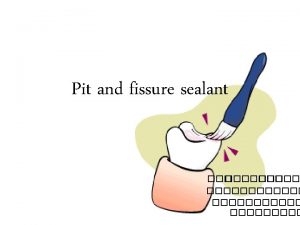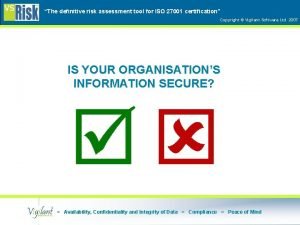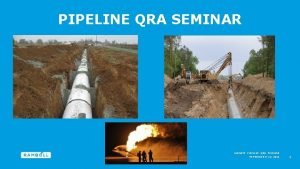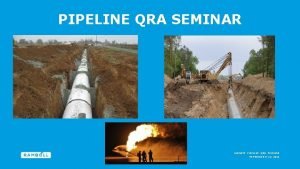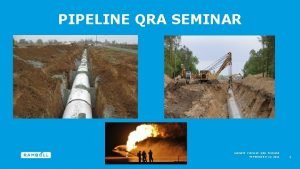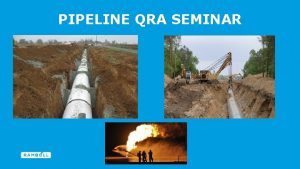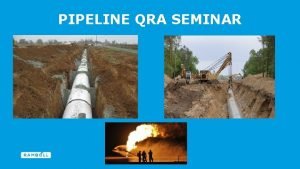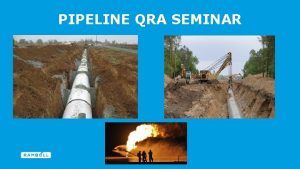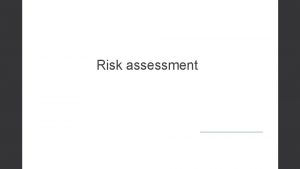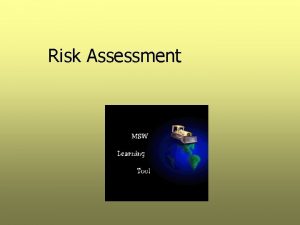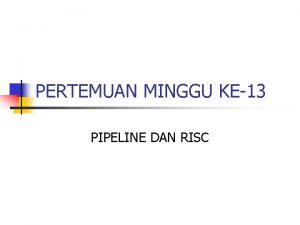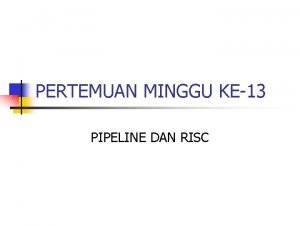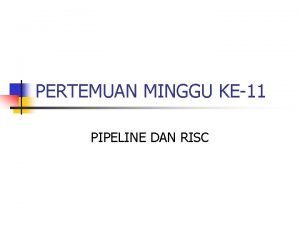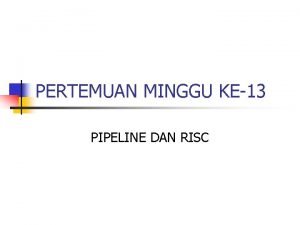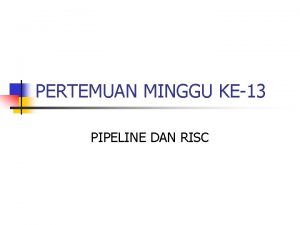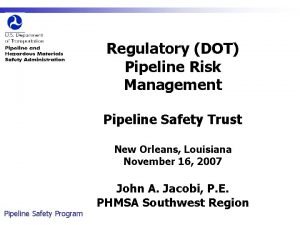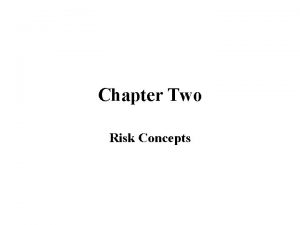PIPELINE QRA SEMINAR PIPELINE RISK ASSESSMENT INTRODUCTION TO






























- Slides: 30

PIPELINE QRA SEMINAR

PIPELINE RISK ASSESSMENT INTRODUCTION TO HAZID 2

INTRODUCTION TO HAZID Description “HAZID is a structured, team based approach to identify hazards, their potential consequences, and requirements for risk reduction” 3

INTRODUCTION TO HAZID • What is the purpose of HAZID? -For the defined system, identify relevant hazards and their causes and potential consequences -Document any existing safeguards (i. e. preventing the hazard and/or consequences from the hazard) -Assess the risk (i. e. assess the probability/frequency and consequences) associated with the identified hazards -Make recommendations and assign actions to eliminate, prevent, control or mitigate the identified hazards 4

INTRODUCTION TO HAZID • Difference between risk and hazard? • Risk could be described as the exposure to a hazard • Hazard – any event/object that could cause harm • Hazard – a crocodile / Risk – exposed to a crocodile • More academic importance 5

INTRODUCTION TO HAZID • Team-based workshop -HAZID chairman -HAZID scribe -Participants • Different responsibilities within the HAZID team • Composition and size of the team depending on the situation (e. g. complexity) • Preferable smaller group (i. e. less than 10) 6

INTRODUCTION TO HAZID • Participants appropriate knowledge and experience (i. e. experts for the different parts of the system) • Participants appropriate knowledge and experience (e. g. operational personnel) -Maintenance -Safety -Process • Stakeholders (e. g. contractor, consultant, client and authorities) 7

INTRODUCTION TO HAZID • Structured – use of guidewords (established before the workshop) • Specific guidewords for the situation and system (combination of guidelines, company specific and experience) • Purpose of assisting in the identification or hazards 8

EXAMPLE OF HAZID 9

EXAMPLE OF HAZID 10

EXAMPLE OF HAZID 11

EXAMPLE OF HAZID 12

INTRODUCTION TO HAZID • Difficulties in determine what is actually the hazard, the cause and the consequence -The hazard (i. e. leak of hydrocarbon from a pipeline system) -The cause of an event (i. e. corrosion which causes a leakage from the pipeline) -The resulting consequence of an event (i. e. fire after ignition of the leakage from the pipeline) -The hazard (i. e. corrosion which causes a leakage from the pipeline) -The cause of an event (i. e. damaged corrosion protection on the pipeline) -The resulting consequence of an event (i. e. leak of hydrocarbon from a pipeline system ) • Confusion (i. e. incorrect use – academic importance) • Consistency – use the same approach throughout the HAZID! 13

EXAMPLE OF HAZID 14

EXAMPLE OF HAZID 15

EXAMPLE OF HAZID 16

EXAMPLE OF HAZID 17

INTRODUCTION TO HAZID • What is the purpose of HAZID? -For the defined system, identify relevant hazards and their causes and potential consequences -Document any existing safeguards (i. e. preventing the hazard and/or consequences from the hazard) -Assess the risk (i. e. assess the probability/frequency and consequences) associated with the identified hazards -Make recommendations and assign actions to eliminate, prevent, control or mitigate the identified hazards 18

INTRODUCTION TO HAZID • Sometimes a HAZID only include the risk identification (i. e. where hazards and their causes and consequences are identified) • Most of them time a HAZID also include a qualitative risk assessment (i. e. where the probability/frequency and consequences for the identified hazards are assessed) • Assessment carried out with the support from a risk matrix 19

EXAMPLE OF HAZID 20

EXAMPLE OF HAZID 21

EXAMPLE OF HAZID 22

INTRODUCTION TO HAZID • A number of actions to eliminate, prevent, control or mitigate the hazards are assigned at the workshop -Additional information -Inspections -Detailed studies -Detailed calculations -Changes in the design • Based on the close-out of these actions (and possible implementation) an updated risk assessment (residual risk) • Carried out weeks or months after the workshop 23

EXAMPLE OF HAZID 24

EXAMPLE OF HAZID 25

INTRODUCTION TO HAZID • The hazards are recorded in the HAZID sheet • The actions are recorded in action sheets • The workshop is presented in the HAZID report -Presentation of the HAZID sheet (i. e. the information established at the workshop) -Presentation of the action sheets -Information on the workshop (e. g. participants, guidewords and methodology) • Updated based on the close-out of actions and updated risk assessment (residual risk) 26

INTRODUCTION TO HAZID Advantages of HAZID • Flexibility (e. g. concept – high-level hazards / detailed design – detailed hazards) • Flexibility (e. g. could be used to analyse one concept or compare two different concepts) • Thorough (i. e. systematic approach) • Well documented (e. g. easy to keep track on information) 27

INTRODUCTION TO HAZID Disadvantages of HAZID • Information (i. e. strongly depending on the information available) • HAZID team (i. e. depending on the expertise and experience within the team) • Close-out of actions (i. e. depending on the commitment from management) • Effectiveness (i. e. only effective if the hazards identified are resolved and appropriate actions implemented) 28

INTRODUCTION TO HAZID • Round-around the table (i. e. speak up your strongest concerns regarding possible hazards) before going into the guidewords • Gathering experts for the different parts of the system often leads to discussion of things which might not actually be a hazard (more cross-disciplinary problems) – keep focus on the hazards! • Spend some time defining the actual system (e. g. boundaries and project phase) 29

QUESTIONS? 30
 Aloha risk assessment software
Aloha risk assessment software Qra example
Qra example Market risk assessment
Market risk assessment Linear pipelining
Linear pipelining Superscalar pipeline design
Superscalar pipeline design Pipeline risk modeling
Pipeline risk modeling Hazid example
Hazid example Seminar presentation in english
Seminar presentation in english Left driving countries
Left driving countries Seminar opening lines
Seminar opening lines Debate introduction examples
Debate introduction examples Draw rmmm plan
Draw rmmm plan Risk reduction vs risk avoidance
Risk reduction vs risk avoidance Relative risk calculation
Relative risk calculation Residual risk and secondary risk pmp
Residual risk and secondary risk pmp Inherent risk vs control risk
Inherent risk vs control risk Absolute risk vs relative risk
Absolute risk vs relative risk Activity sheet 1: conservative, moderate or speculative?
Activity sheet 1: conservative, moderate or speculative? Risk classification
Risk classification Risk financing transfer adalah
Risk financing transfer adalah The biggest risk is not taking any risks
The biggest risk is not taking any risks Fiduciary investment risk management association
Fiduciary investment risk management association Ir x cr x dr
Ir x cr x dr Business risk and financial risk leverage
Business risk and financial risk leverage Attributable risk
Attributable risk Risk map risk management
Risk map risk management Parirt
Parirt Tera toxicology
Tera toxicology Caries risk assessment form
Caries risk assessment form 27001 risk assessment software
27001 risk assessment software Risk assessment fraud
Risk assessment fraud
